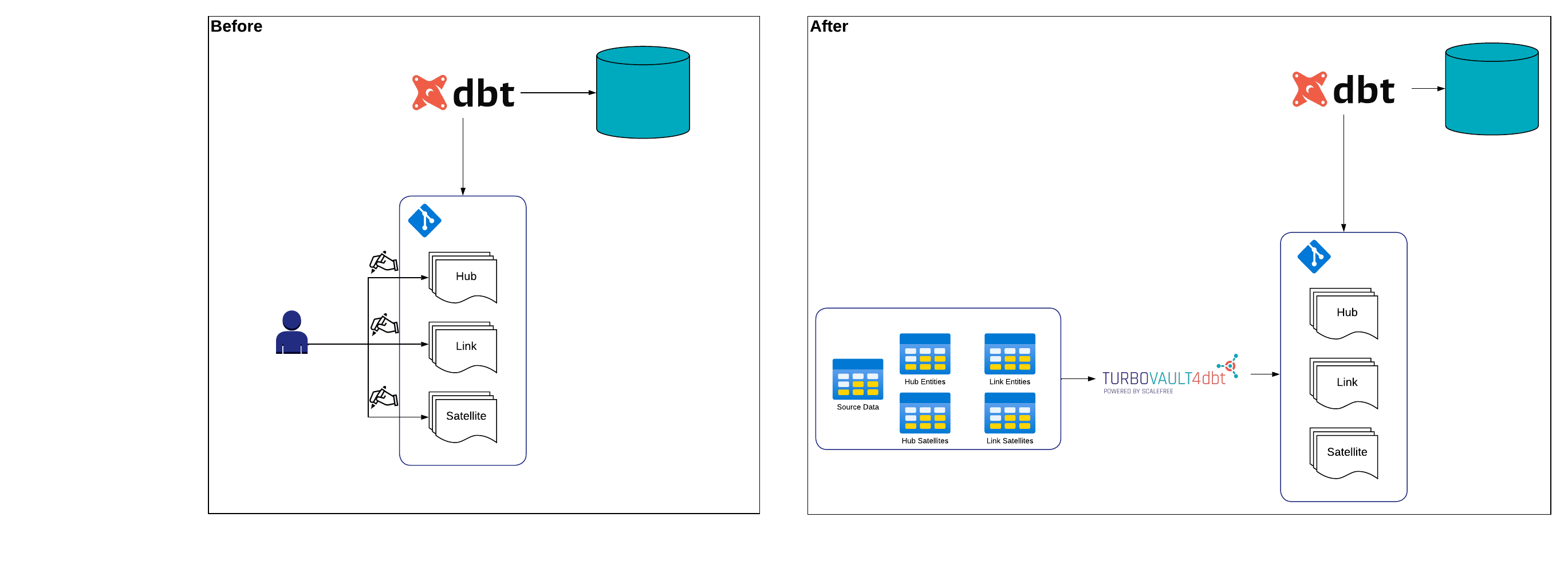TurboVault4dbt
Scalefree released TurboVault4dbt, an open-source package to automate model generation using DataVault4dbt-compatible templates based on your sources’ metadata.
TurboVault4dbt currently supports metadata input from Excel, GoogleSheets, BigQuery, and Snowflake and helps your business with:
- Speeding up the development process, reducing development costs, and producing faster results
- Encouraging users to analyze and understand their source data
Speed up Your Data Vault 2.0 Implementation – with TurboVault4dbt
This webinar delves into TurboVault4dbt, an open-source tool by Scalefree that speeds up Data Vault 2.0 implementation. It automates dbt model creation using your source metadata, saving time and costs while encouraging better data analysis.
TurboVault4dbt works with metadata inputs like Excel, Google Sheets, BigQuery, and Snowflake, generating models for hubs, links, and satellites automatically. Just set up your metadata tables, connect the tool, and watch it do the heavy lifting!
‘Isn’t every model kind of the same?’
Datavault4dbt is the result of years of experience in creating and loading Data Vault 2.0 solutions forged into a fully auditable solution for your Data Vault 2.0 powered Data Warehouse using dbt.
But every developer who has worked with the package or has created dbt models for the Raw Vault must have come across one nuisance:
Creating a new dbt model for a table means taking the already existing template and providing it with specific metadata for that table. Doing this over and over again can be quite a chore. This is why we created TurboVault4dbt to automate and speed up this process.
From CTRL+C AND CTRL+V to a simple mouse-click
How many times has everyone pressed CTRL+C then CTRL+V and corrected a few lines of code when creating new dbt-models for the raw vault?
Instead of trying to figure out what the names of your tables and business keys are or what hashing order you want your Hashkey to be generated in, TurboVault4dbt will do all of that for you. All TurboVault4dbt needs is a metadata input where you capture the structure of your data warehouse.

TurboVault4dbt currently requires a structure of five metadata tables:
- Hub Entities: This table stores metadata information about your Hubs,
e.g. (Hub Name, Business Keys, Column Sort Order for Hashing, etc.) - Link Entities: This table stores metadata information about your Links,
e.g. (Link Name, Referenced Hubs, Pre-Join Columns, etc.) - Hub Satellites: This table stores metadata information about your Hub Satellites,
e.g. (Satellite Name, Referenced Hub, Column Definition, etc.) - Link Satellites: This table stores metadata information about your Hub Satellites,
e.g. (Satellite Name, Referenced Link, Column Definition, etc.) - Source Data: This table stores metadata information about your Sources,
e.g. (Source System, Source Object, Source Schema, etc.)
By capturing the metadata in those five tables above, TurboVault4dbt can extract necessary information and generate every model that is based on a selected source but also, as a user, encourage you to analyze and understand your data.
Conclusion: Lean back, relax and let TurboVault4bdt take over!
Create and fill your metadata tables, connect them to TurboVault4dbt, and enjoy your free time for another cup of coffee. Give it a try, or give us your feedback by visiting TurboVault4dbt on GitHub!
Stay updated on TurboVault4dbt through our marketing channels as great features lie ahead!
– Hoa Le (Scalefree)

